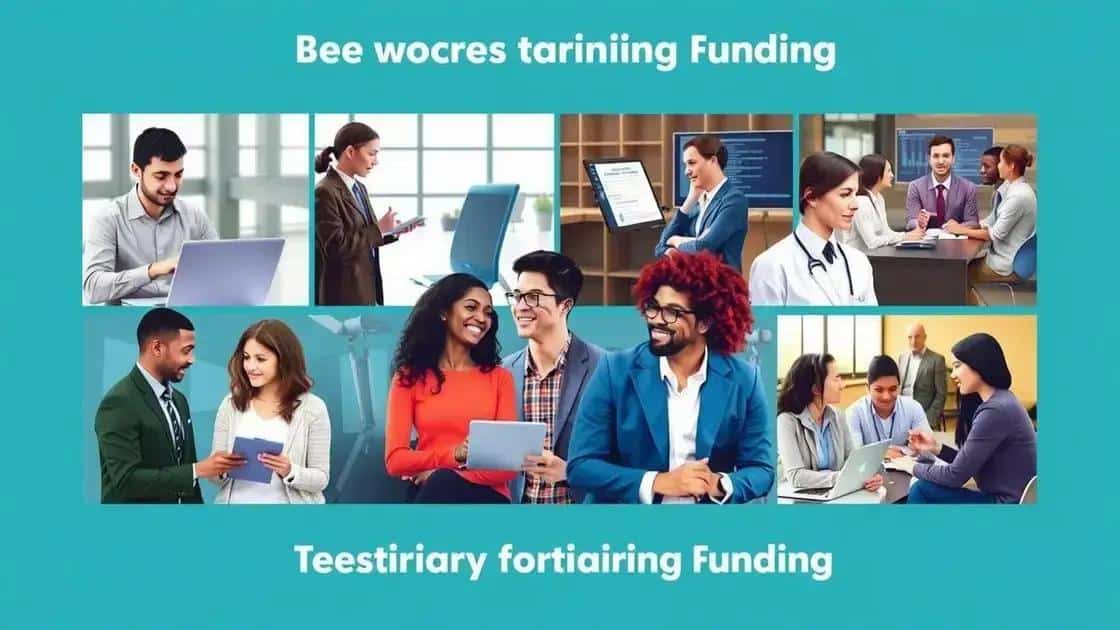Workforce training grants trends you shouldn’t miss

Workforce training grants provide financial support for individuals seeking to enhance their job readiness through skill development, enabling better employment opportunities and career advancement.
Workforce training grants trends are shaping the future of educational funding and workforce development. Ever wondered how these changes might open new doors for your career?
Understanding workforce training grants
Understanding workforce training grants is essential for anyone looking to enhance their skills or advance in their career. These grants can provide the financial support needed to pursue various training programs, making professional development accessible.
When considering workforce training grants, it’s important to know how they function. They are typically offered by government agencies, non-profits, and sometimes private organizations to fund educational programs aimed at improving workforce skills.
Types of Workforce Training Grants
There are several types of grants available, each designed to meet different needs:
- Federal grants, which may have specific requirements based on industry and location.
- State-funded programs that reflect local job market demands.
- Employer-sponsored grants that companies provide for their employees.
Applying for these grants can seem daunting. However, knowing the prerequisites can simplify the process. Many grants require documentation like proof of income, education background, and sometimes even a statement of purpose detailing how the training will benefit your career.
How to Find Training Grants
To locate workforce training grants, you can utilize several resources:
- Online databases that consolidate available funding opportunities.
- Local job centers that often have the latest information on training grants.
- Networking with industry professionals can also reveal hidden opportunities.
Once you find potential grants, pay attention to deadlines and required documentation. A well-prepared application increases your chances of receiving funding. Additionally, consider reaching out to grant managers for clarification on the application process if needed.
Current trends in workforce training funding

Current trends in workforce training funding reveal significant changes in how organizations support skills development. With the rapid advancement of technology, funding sources are adapting to meet the evolving needs of the labor market.
One prominent trend is the increased emphasis on online training programs. Many students and professionals prefer flexible learning options that allow them to balance work and education. Thus, funding is increasingly being directed towards digital platforms that offer virtual courses and webinars.
Corporate Partnerships
Another trend is the rise of corporate partnerships with educational institutions. Companies realize that partnering with schools can help create tailored training programs that address specific skill gaps.
- These collaborations often lead to more relevant programs.
- They can provide resources and expertise that enhance training quality.
- Sponsorships from companies help cover the costs of training for employees.
Funding is also shifting towards programs that focus on underrepresented groups in the workforce. Initiatives aimed at promoting diversity often attract government support and non-profit funding. These efforts aim to ensure inclusive access to educational opportunities that might have been unavailable in the past.
Shift in Government Funding Priorities
In recent years, government funding priorities have undergone a transformation. There is a stronger focus on skills that prepare individuals for high-demand jobs, especially in areas like technology and healthcare. This shift is reflected in how grants are allocated.
- Programs that offer training in emerging industries receive more attention.
- Funding is increasingly competitive, driving organizations to innovate.
- Collaboration among different stakeholders in workforce development is becoming critical.
Overall, understanding these trends helps individuals and organizations navigate the complex landscape of workforce training funding. By staying informed, they can make strategic decisions about training and development initiatives.
How to apply for workforce training grants
Applying for workforce training grants can be a straightforward process if you know what to focus on. Many organizations offer grants, each with unique requirements and guidelines. Understanding these details is crucial to increasing your chances of success.
The first step in the application process is to research available grants that fit your needs. Many websites compile lists of workforce training grants, making it easier to find the right one for you. Always read the eligibility criteria carefully to ensure you qualify for the funding.
Gather Necessary Documents
Once you identify a suitable grant, start gathering the required documents. Commonly needed items include:
- Proof of income or financial need.
- Past transcripts or diplomas to showcase your educational background.
- A personal statement explaining why you are applying.
Having these documents ready will speed up the application process and help you present a strong case.
Write a Compelling Application
The next step is writing your application. Make it clear and persuasive. Include information about how the funding will enhance your skills and career prospects. It’s important to relate your goals to the objectives of the grant. A well-developed narrative can significantly impact the reviewers.
- Be concise and to the point.
- Highlight your qualifications and motivation.
- Use specific examples of how training will benefit your career.
After completing your application, take time to review and edit it. Look for grammatical errors and ensure all required information is included. It’s also beneficial to have someone else read it for clarity and feedback.
Finally, submit your application by the deadline. Late submissions are usually not considered. Following these steps carefully will help you navigate the process of applying for workforce training grants successfully.
The impact of workforce training on job readiness

The impact of workforce training on job readiness is significant for both employees and employers. When individuals receive proper training, they are often better equipped to meet the demands of the job market. Employers benefit from having a skilled workforce, which can lead to higher productivity and innovation.
One of the key ways training influences job readiness is by providing essential skills. Programs that focus on hands-on learning allow participants to gain practical experience, which is crucial for success in many fields. This type of relevant training ensures that individuals can perform specific tasks effectively.
Benefits of Skill Development
Skill development through workforce training has several advantages:
- Increased confidence in job performance.
- Better understanding of industry standards and expectations.
- Enhanced problem-solving abilities that are critical in today’s work environments.
Moreover, comprehensive training programs are tailored to reflect current workforce needs, ensuring participants remain competitive. For example, training that includes the latest technology prepares workers for modern job requirements, making them invaluable assets to their employers.
Long-Term Career Outcomes
Training not only prepares individuals for immediate job roles but also contributes to their long-term career advancement. When a person is well-trained, they are more likely to seek further opportunities and promotions. This upward mobility enhances job satisfaction and retention for both employees and employers.
- Employees with training are more likely to stay with a company.
- Investment in employee development attracts talent.
- Improved employee skills lead to better company performance.
In conclusion, the connections between workforce training and job readiness are clear. Employers who prioritize training will find that their workforce is not only ready to tackle current demands but also prepared for future challenges.
FAQ – Frequently Asked Questions about Workforce Training Grants
What are workforce training grants?
Workforce training grants are funds provided by government agencies or organizations to support individuals in acquiring new skills for employment.
Who is eligible to apply for these grants?
Eligibility varies by grant but typically includes individuals seeking training or organizations that provide training programs.
How can workforce training impact my career?
Workforce training enhances your skills, increases job readiness, and can lead to better job opportunities and career advancement.
What documents do I need to apply for a workforce training grant?
Common required documents include proof of income, transcripts, a personal statement, and sometimes letters of recommendation.





